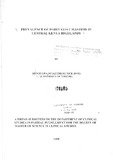| dc.description.abstract | One hundred and thirty does in seven dairy goat farmer groups in Nyeri district (Central
Province) were examined to determine the prevalence and aetiology of mastitis and risk
factors associated with it. The goats, which were registered with the Kenya studbook,
comprised of a mixed population of Saanen, Toggenburg, Small East African and German
Alpine crosses.
The selected does, most (91 %), of which were under zero grazing system were sampled over
a three-month period. During each visit breed, kidding dates, stage of lactation, parity, litter
size, milk yield and purpose of milk were recorded. A total of 260 samples were obtained
from 130 lactating does and tested for mastitis using bacteriological and cytological
techniques (indirect and direct somatic cell count).
The overall prevalence of infected glands was 39% while that of infected does was 58%.
The prevalence of subclinical mastitis in the various dairy goat farmer groups ranged from
22% to 76% with groups in Mathira division having significantly (p<0.05) higher prevalence
rates than the other divisions.
Various bacterial isolates were found with the most frequent ones being Staphylococcus spp
(78%) and Micrococcus spp (16%). Of the Staphylococcus spp isolated, 71% were the
coagulase negative while 29% were coagulase positive.
Poor milking hygiene i.e.not washing the udder before milking, not applying milking salve
before milking and not dipping teats after milking, significantly (p<0.05) influenced the
prevalence of mastitis. Similarly, does that were housed in temporary earthen floor
enclosures had significantly higher (p<0.02) mastitis prevalence rates than those on raised
slatted houses. These findings indicate that particular attention should be given to the design
of dairy goat housing and milking hygiene which were found to be significantly (p<0.02)
associated with the level of subclinical mastitis in the farms. It is suggested that preventive
measures, including improvement of housing structures and application of good milking
hygiene, be instituted before the disease takes root in the dairy goat flocks.
In this study, when direct leucocyte count was used as the true indicator of infection,
California mastitis test score of 3 was found to be highly sensitive and specific in detecting
mastitis in does. Bacteriology, however, was found to be highly sensitive (>75%) but mildly
specific (50%). Thus the mere isolation of microorganisms from milk samples may not be a
true indicator of infection. Due to its high sensitivity and specificity, direct leucocyte count
is the best test to be used in confirming mastitis diagnosis but it is not practical under field
conditions. As an alternative a CMT score of 3 may be used as confirmatory of mastitis
during surveillance of the disease in dairy goat flocks. | en |

